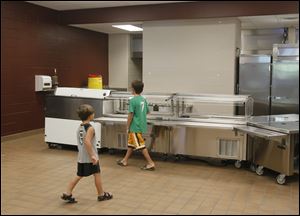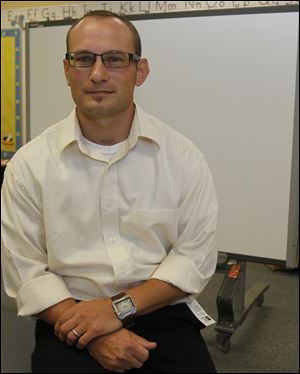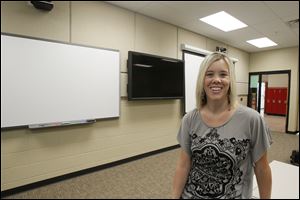
EDUCATION MATTERS
Toledo Public system gets a makeover
District switches to K-8 model, learning labs
8/28/2011
Rogers High School Principal Kelly Welch is shown in the school’s distance learning lab. More than 200 students have signed up to take classes in the labs.
THE BLADE/JETTA FRASER
Buy This Image

Kindergarten teacher Cathy Harris sets up her classroom at DeVeaux for incoming students. DeVeaux has been transformed from a middle school to a K-8 school.
It can be hard to tell what isn’t changing this year at Toledo Public Schools.
Students return to classes across the city Monday, and much will be different. The 2011-2012 academic year is in many ways a crossroads for the Toledo district, where major elements of its transformational plan are implemented. There are changes galore at Toledo schools.
Gone are elementary and middle schools. Back are seventh and eighth-grade sports. Changed is the special education approach. New buildings open with new technologies.
The most apparent, and likely dramatic, change students, parents, and teachers will notice this year is the district’s new K-8 model.
Part expense saver, part projected grade booster, part community connection piece, the move away from middle and elementary schools and toward K-8 neighborhood schools was the most popular component of the district’s transformational plan.
The shift took months of planning. All the details haven’t been ironed out, evidenced by the “Robinson Middle School” banner that still hangs in the office of what is now Robinson Elementary. Among other changes, entire building attendance boundaries were altered.
And nowhere will the change be bigger than at the former middle schools.

Owen Speer, 4, left, and his cousin Spencer Young, 8, an incoming third grader at DeVeaux, check out the kitchen where lunch will be served. The lunch counters were lowered at the K-8 school to accommodate younger students.
Now, DeVeaux becomes a neighborhood school, pulling students who once went to Longfellow and McKinley. Mr. Henderly, who was a DeVeaux student, said just conceptualizing that the school was now a K-8 was difficult.
“That’s a tough mind-shift to get used to,” he said.
To handle the younger students, former middle schools such as DeVeaux had to be renovated. Lunch counters were lowered. Carpeting was added to kindergarten rooms. Lockers were retrofitted to add lower hooks. There’s more color in the building.
But the biggest change, Mr. Henderly said, is the building’s cultural shift. Before, when there were 950 students, being principal felt like running a business, he said. With a projected enrollment of about 400 this year, there’s less management.
“We are now running a school,” Mr. Henderly said.
Grades will largely be segregated from each other. Kindergarten through third graders occupy one DeVeaux first-floor wing, with seventh and eighth-graders on the other. Grades four, five, and six are upstairs.
Cindy Skaff, a DeVeaux eighth-grade teacher, said she’s looking forward to a more familylike environment now that the school is K-8. She also gets to return to her roots; the former math specialist hasn’t taught math for 16 years.
“I’m excited to teach math again,” she said.
An inclusive move
Thousands of students in Toledo’s public schools have disabilities, from autism or Down syndrome, to dyslexia or a computational weakness in math.

DeVeaux Principal Chad Henderly said just conceptualizing that the school is now K-8 has been difficult.
It’s both a philosophical shift and one district leaders expect to garner academic gains.
“We have a lot of students who are learning disabled who have normal IQs but have difficulty with one subject,” TPS Chief Academic Officer Jim Gault said. “It’s our belief they should be in regular classrooms, with support.”
Now, special education teachers and paraprofessionals will be dedicated to grades, not specific classrooms, floating from room to room to aid special-education students. Decisions will be based on individual education plans, but Mr. Gault said all but the most physically fragile students will be moved to regular classrooms.
Regular classroom teachers will team-teach with special education teachers; staff will be trained on new techniques required in the approach.
District officials cite research to support the inclusion model and argue it will improve both student esteem and academic performance. Cincinnati moved to an inclusion model several years ago and now is the only major urban district in Ohio that’s reached the effective rating on the state’s school report card system.
The changes meant a shift in staffing. Personal learning tutors who did one-on-one work have been replaced by paraprofessionals because the tutors were not specifically licensed to be the primary means of instruction for students. But students will still get the same level of service under the approach as before, Mr. Gault said.
Learning from afar

Rogers High School Principal Kelly Welch is shown in the school’s distance learning lab. More than 200 students have signed up to take classes in the labs.
Distance learning labs open at the schools this fall. Students across the district take classes in the labs, with lessons transmitted in from a teacher in one of the locations. The labs allow the district to boost its advanced-placement and foreign-language courses at its high schools without having to pay for the teachers at all the schools. Students will be able to take classes such as Chinese or advanced-placement American government.
There are flat-screen TVs and microphones galore in the new rooms. More than 200 students have signed up to take classes in the labs.
Eventually, students will be able to take postsecondary classes through local universities without leaving their high schools. But for now, the district is looking just to get students, and teachers, acclimated to the concept.
“The teachers were nervous during training,” assistant superintendent Brian Murphy said during a demonstration of the labs earlier this month. “But now, they are excited.”
Contact Nolan Rosenkrans at: nrosenkrans@theblade.com or 419-724-6086.